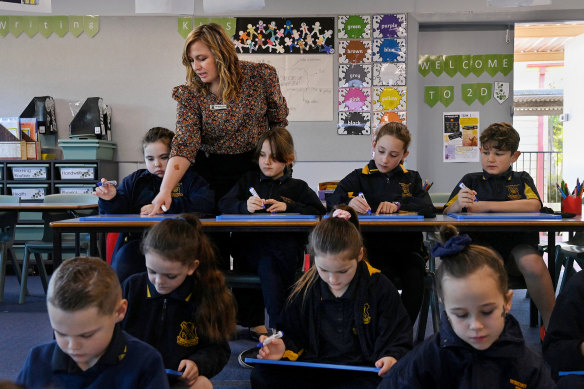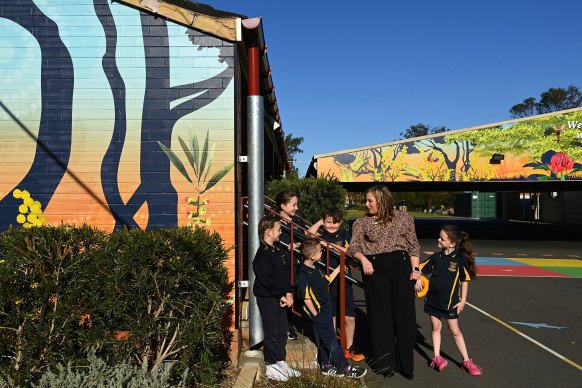By Lucy Carroll
NSW’s primary school curriculum will include more facts, detailed content and core knowledge students need to master under a radical rewrite of syllabuses that shifts away from the student-led approach to learning that has dominated for decades.
An overhaul of four syllabuses – science, history and geography, creative arts and PDHPE – will also embed writing content in each course to equip students with vital literacy skills before high school.

Kerryn Carter, assistant principal at Windsor South Public School, with year 2 students. Credit: Kate Geraghty
For the first time, primary-aged students will be taught about the human body in science lessons, learning about skeletal, respiratory and circulatory systems.
In history and geography, the revamped syllabus contains specific content students must learn about the roles of government, key events in Federation and the origins of Australia’s democratic system. From kindergarten, students will study the ancient past, including places and cultures in China, Egypt and Greece.
The upgraded course documents released on Wednesday come six years after then-education minister Rob Stokes announced a root-and-branch review of the kindergarten to year 12 NSW curriculum. The review, led by Geoff Masters, aimed to arrest a decades-long slump in international test results.
“This is the biggest change to NSW syllabuses in a couple of decades, possibly longer,” said Paul Martin, chief executive of the NSW Education Standards Authority (NESA).
“The last time the state’s primary curriculum was written, there were different understandings of how students learn and how classrooms are arranged. The education landscape has shifted since then – for the better.”
Martin said some earlier NSW syllabuses were written “At a high point of what I would call progressivist education ideology ... Syllabuses had less rigour, included more inquiry and student-led learning. They were more open to interpretation.
“Parents should be able to clearly understand what their children are learning at school in each year. The new syllabuses make it clearer for parents.”
In PDHPE, key changes include teaching respectful relationships and age-appropriate consent from kindergarten, and more explicit teaching of fundamental movement skills.
Detailed civics and citizenship content is in the human society and its environment (HSIE) syllabus, including the origins of the parliamentary system, the rule of law and the purpose of the constitution.
More specific content about earth, space and gravity is included in science.
The new curriculum, which schools can plan for from next year, will become mandatory in 2027. Last year, NSW Education Minister Prue Car delayed the release of multiple syllabuses to bring the schedule in line with the 10-year timeframe outlined in the Masters-led review.
Car called the new syllabuses a significant milestone. “For the first time, primary school teachers have a set of syllabuses that make sense together and will ensure students have a strong foundation upon which to build their knowledge,” she said.
Primary schools are already teaching updated English and maths syllabuses. The English syllabuses included a focus on phonics and more explicit teaching of grammar, punctuation and sentence structure in primary and high school.

Assistant principal Kerryn Carter said more explicit writing content in science and HSIE courses would help boost literacy skills.Credit: Kate Geraghty
Critics previously warned that the national curriculum and state-based syllabuses were too vague and ambiguous, contributing to teacher workloads.
Ben Jensen, who last year studied the nation’s science curriculum and found Australia was setting students up for failure against top-performing countries, welcomed the changes.
“High-performing systems that have greater equity are more specific about what is taught in school classrooms,” he said.
“When you pick up the new NSW syllabuses, it looks a lot more like a high-quality curriculum from a top-performing country like Hong Kong, Japan or Singapore.”
However, he warned that teachers also need access to high-quality curriculum resources, directions on which lesson plans to use and professional development.
Martin said the syllabuses were carefully sequenced and knowledge-based. “They outline what teachers should teach and what students are expected to know,” he said.
He explained that NESA drew on cognitive science research of educational experts Professor John Sweller, Daniel Willingham and American education guru ED Hirsch, who emphasised a knowledge-rich curriculum was key in closing the vast achievement gap.
“It’s probably common sense to a lot of parents. The intention is that when students enter year 7, it is not this massive jump from year 6. We have to teach kids sequentially and explicitly. It is not acceptable to be finishing primary school not able to read,” Martin said.
Assistant principal curriculum and instruction at Windsor South Public Kerryn Carter said the syllabuses have been developed together for the first time in 50 years.
“Ambiguous content has been taken out, so there is less room for guessing. Content and student outcomes when learning about Aboriginal culture, history and peoples is much clearer,” she said.
“Explicit writing content, which focuses on vocabulary and sentence construction, means students will have more writing practice and will in turn help build more knowledge.”
Start the day with a summary of the day’s most important and interesting stories, analysis and insights. Sign up for our Morning Edition newsletter.